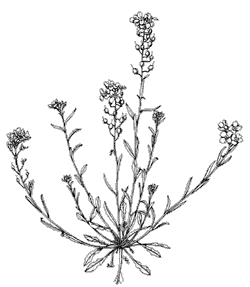Brassicaceae (Cruciferae)
(mustard family)
The mustards number about 3000 species worldwide, most of which are herbs. Some important vegetables such as radish, broccoli and cauliflower are in this family. Most Sonoran Desert species go unnoticed except by botanists, because they are inconspicuous even though sometimes abundant. Two attractive wild- flowers are bladderpod (Lesquerella gordoni) and silver bells (Streptanthus carinatus).
 |
The greater story of mustards in the desert is that some alien species are pernicious weeds. The most disturbing is probably Sahara or Moroccan mustard (Brassica tournefortii). First discovered in the United States only in the 1930s, it has by now invaded most of the dry sandy areas of the Sonoran Desert. Unlike most pioneer plants (weeds) it doesnít require disturbed soil to invade. In wet years it forms extensive, dense stands that crowd out the native annuals. Because most birds and mammals will not eat it, this mustardís displacement of native species presumably has detrimental effects all the way up the food web. Many potential wildflower displays have also been thwarted by this one weed. Another alien mustard, London rocket (Sisymbrium irio), is a major pest in disturbed soils and gardens.










